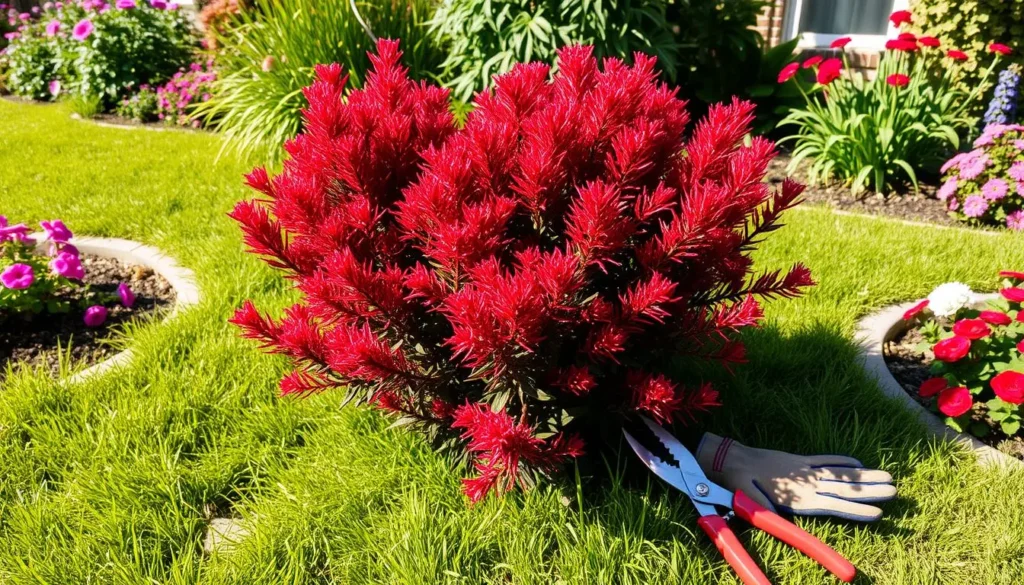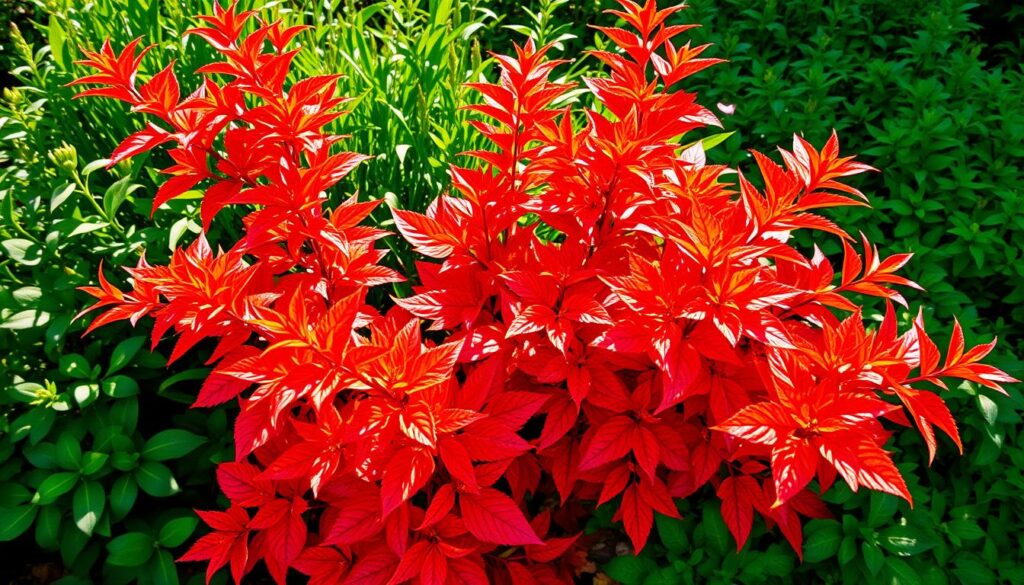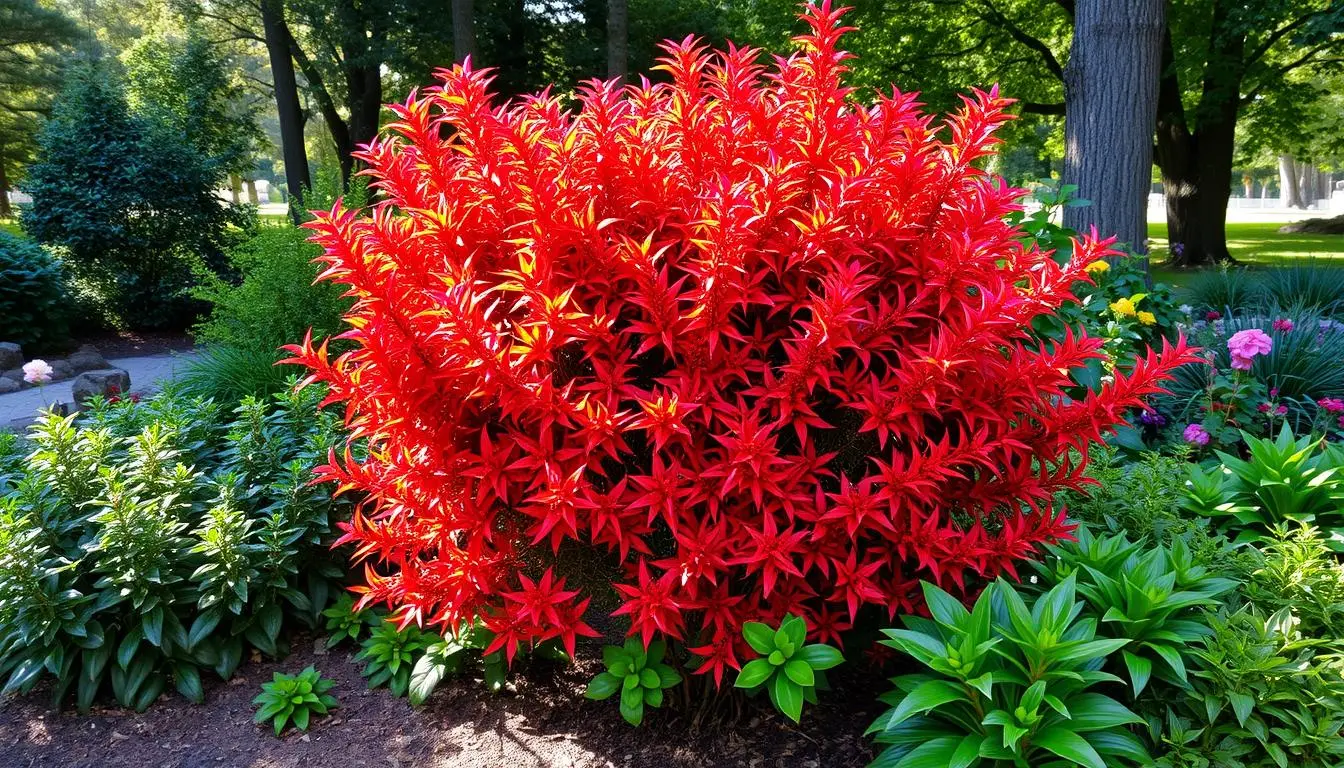As the crisp autumn breeze whispers through the trees, one shrub stands out with its vibrant, fiery display – the burning bush. This captivating plant has long been a favorite among gardeners. It captivates the senses with its rich hues and effortless charm. Whether you’re a seasoned green thumb or a novice cultivator, this guide will equip you with the essential knowledge to cultivate a thriving burning bush in your own backyard oasis.
Table of Contents
Understanding the Burning Bush Shrub
The burning bush, known as Euonymus alatus, is a stunning deciduous shrub from eastern Asia. It’s found in places like China and Japan. Its striking color changes and unique growth make it a favorite for gardeners in the United States.
Native Habitat and Growth Characteristics
In its natural home, the burning bush loves woodland areas and forest edges. It grows 6 to 15 feet tall and spreads 8 to 12 feet wide. Its branches have corky wings, making it visually appealing.
Common Varieties and Species
- The Chinese burning bush (Euonymus alatus ‘Compactus’) is a favorite for its compact size, reaching 6 to 8 feet tall.
- The winged burning bush (Euonymus alatus) has more noticeable corky wings on its branches.
- The broad-leaf burning bush (Euonymus phellomanus) has larger, broader leaves than the traditional burning bush.
Seasonal Color Changes and Appearance
The burning bush’s most exciting feature is its color change with the seasons. In spring and summer, its leaves are a bright green. As fall comes, the leaves turn into vibrant red, orange, and purple, earning it the name “burning.” This colorful show lasts for weeks, making it a top choice for gardens.
“The burning bush is a true autumn showstopper, lighting up gardens and landscapes with its vibrant, fiery display.”
Best Growing Conditions for Your Burning Bush
To grow a healthy burning bush, knowing the right conditions is crucial. This shrub does well in certain climates and soils. Adding the right perennials can make your garden look even better.
The burning bush, or Euonymus alatus, loves zones 4 to 9. It needs a climate with four seasons to show off its fall colors. It grows best in well-drained, slightly acidic soils with lots of organic matter.
When planning your garden, pick burning bush companion plants that need similar things. Good choices include perennials like Autumn Joy sedum, Japanese maple, and ornamental grasses. These plants make a beautiful mix with the burning bush’s bright colors.
By knowing what the burning bush needs and choosing the right perennials, you can create a stunning garden. It will highlight the beauty of this amazing shrub.
Planting Time and Location Selection
Planting a burning bush at the right time and place is key. The fall season is best for planting. The soil is warm, and the plant can grow roots before winter.
This helps the shrub thrive and grow strong for the next season.
Ideal Soil Conditions
Burning bushes love well-drained, rich soil with a slightly acidic pH. This is between 5.5 and 6.5. They prefer moist soil but not too wet to avoid root rot.
Adding compost or organic matter to your soil can help your burning bush grow well.
Spacing Requirements
- Make sure to leave enough space between each burning bush for growth.
- A spacing of 6 to 8 feet is good to give the shrub room to grow.
- Good spacing prevents overcrowding and ensures each plant gets enough sunlight and air.
Sun Exposure Guidelines
Burning bushes need full sun to partial shade, depending on your area. In hot summers, some afternoon shade helps prevent leaf scorch. But in milder summers, full sun is best for color and health.
Follow these tips for planting time, soil, spacing, and sun. This will help your burning bush thrive and look great every year.
Essential Care and Maintenance Tips
Caring for your burning bush plant is key to its vibrant growth and lasting beauty. Regular checks, proper mulching, and pest control are crucial. These steps help your burning bush thrive and enjoy its stunning color changes every year.
Regular Inspections
Regularly check your burning bush for signs of trouble. Look for wilting leaves, discoloration, or pests. Quick action can prevent damage and keep the plant healthy.
Mulching for Moisture Retention
Use organic mulch around the base of your burning bush. It keeps the soil moist and stops weeds. This helps the plant get enough water and grow well.
Proactive Pest Management
- Watch for pests like aphids, scale insects, or spider mites.
- Deal with pests fast, using eco-friendly methods if needed.
- A healthy plant can fight off pests better.
Follow these care tips to keep your burning bush vibrant and healthy. It will be a stunning part of your landscape for years.
“The burning bush is a true testament to the beauty and resilience of nature. With proper care, it can flourish and captivate onlookers season after season.”
Watering and Fertilizing Requirements
To keep your burning bush healthy and colorful, you need to balance watering and fertilizing. Knowing what your shrub needs in each season helps it grow well in your garden.
Water Schedule Throughout Seasons
The burning bush needs moderate water, but the right amount changes with the seasons. In spring and summer, water it deeply once a week. Make sure the soil is moist but not too wet.
In autumn, cut back to watering every two weeks. This helps it get ready for winter. In winter, only water when the soil is very dry.
Fertilizer Types and Application
To get lush leaves and bright autumn colors, fertilize in early spring. Use a balanced, slow-release fertilizer. Spread it evenly around the plant, following the instructions on the package.
Don’t overdo it with the fertilizer. Too much can cause weak growth.
Soil pH Management
- The burning bush likes slightly acidic soil, with a pH of 5.5 to 6.5.
- If your soil is too alkaline, add sulfur or iron sulfate to lower the pH.
- Test the soil pH often and adjust as needed. This ensures your burning bush stays healthy and colorful.
By following these tips for watering, fertilizing, and managing soil pH, you’ll create perfect conditions for your burning bush. It will thrive and add stunning color to your garden.
Pruning and Shaping Techniques
To keep your burning bush looking great, you need to prune and shape it right. Follow these tips to keep your shrub healthy and looking good.
Timing is Key
Prune your burning bush in late winter or early spring. This is before new growth starts. Pruning in the hot summer can stress the plant.
Proper Pruning Tools
Use sharp, clean pruning shears or loppers for your cuts. Dull or damaged tools can harm the plant and cause problems.
Shaping Techniques
- Keep the natural shape by removing any branches that don’t fit.
- Thin out the inside to improve air flow and light. This makes the fall colors better.
- Trim long or messy branches to keep the size and shape you want.
By using these burning bush plant care tips, your shrub will stay vibrant and beautiful. It will be a great part of your garden for many years.
“Proper pruning is essential for the long-term health and beauty of your burning bush plant.”

Propagation Methods for Burning Bush
Expanding your burning bush plant collection is rewarding and cost-effective. You can propagate burning bush or learn how to propagate a burning bush using different methods. These include stem cuttings, seed collection, and division. Let’s look at how to grow these vibrant shrubs easily.
Stem Cutting Procedures
Stem cuttings are a popular way to propagate burning bush. Pick healthy, disease-free stems and cut them at a 45-degree angle. Cut just below a leaf node. Then, dip the cut end in rooting hormone powder to help roots grow.
Plant the cuttings in a potting mix that drains well. Keep the soil moist and provide partial shade. Wait until the cuttings have their own roots before moving them.
Seed Collection and Germination
To grow burning bush from seed, collect the small, winged fruits in the fall. They turn bright red. Remove the seeds and plant them in a seed-starting mix right away.
Burning bush seeds need cold stratification. Put the container in the fridge for 4-6 weeks. Then, move it to a warm, sunny spot to help them germinate.
Division Techniques
Division is a simple burning bush propagation method. In early spring or fall, dig up the plant and separate it into smaller sections. Make sure each section has its own roots and stems.
Replant the divisions in well-draining soil and water them well. This will help them establish.
Patience and attention to detail are crucial, no matter the method. With the right care, you can multiply your burning bush collection. Enjoy the vibrant fall foliage for years.
Common Problems and Solutions
The burning bush (Euonymus alatus) is a favorite among gardeners. But, it can face some common problems. Knowing how to solve these issues is key to keeping your bush healthy and looking great.
Pests like aphids, scale insects, and spider mites can harm your bush. They can cause leaves to turn color, grow slowly, and even fall off. Check your plant often and use insecticidal soaps or horticultural oils when needed.
Diseases such as fungal leaf scorch and root rot can also affect your bush. To avoid these, water it right, ensure good air flow, and keep the soil healthy. If you see problems, use fungicides or improve drainage as advised.
Extreme weather, drought, or salt can stress your bush. Make sure it gets enough water, especially when it’s dry. Also, protect it from harsh weather.
While burning bush berries are usually not a problem, some people might get skin irritation or allergies from them. Be careful and wear gloves when pruning or working with the plant.
By watching for problems and fixing them quickly, you can enjoy your burning bush’s beautiful fall colors and shape for many years.
Key Takeaways
- Pests like aphids, scale insects, and spider mites may infest burning bushes.
- Fungal diseases, such as leaf scorch and root rot, can also affect the plant.
- Environmental stressors like drought and extreme temperatures can impact the health of burning bushes.
- Burning bush berries may cause skin irritation or allergic reactions in some people.
- Regular monitoring, appropriate pest and disease management, and proper care can help maintain the beauty of your burning bush.

“With the right care and attention, your burning bush can thrive and bring vibrant color to your landscape for years to come.”
Conclusion
The burning bush is a remarkable shrub that adds vibrant color and interest to your landscape. It thrives in certain conditions, making it a great choice for your garden. By following the right steps, you can enjoy its beauty for many years.
Plant your burning bush in the best spot and take good care of it. It’s also versatile in landscaping, offering many benefits. From its stunning foliage to the uses of burning bush oil, it’s a great addition to any garden.
Follow the tips from this article to grow a thriving burning bush. It will be a beautiful addition to your outdoor space. Growing this plant can bring joy and inspiration to your garden for seasons to come.

